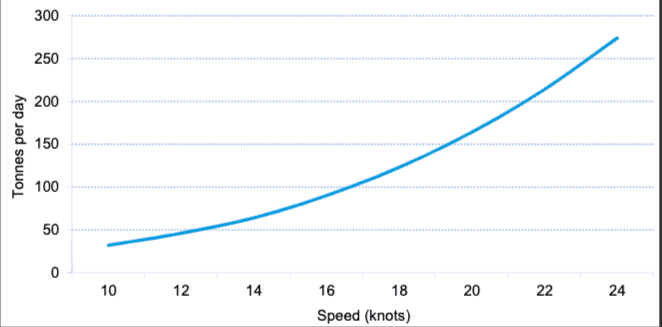Among the topics to be taken up by this week’s meeting of ocean shipping’s international regulator will be how the industry can lower its carbon dioxide output.
One increasingly talked-about method is reducing ship speeds. Lower speeds reduce a ship’s overall fuel use, thereby reducing its carbon dioxide output.
Container lines have not welcomed the idea due to the need to add more ships to meet the same schedules. But Drewry Shipping Consultants said slower speeds may have some benefits for the industry, but only up to a certain point.
The International Maritime Organization’s (IMO) meeting in London will look at a proposal, first suggested by representatives from France, to reduce ship speeds. The goal is to cut shipping’s carbon output 40 percent by 2030.
The plan has since gained steam with environmental groups and some shipping companies. A group of 120 shipping companies signed a letter supporting a limit on maximum ship speeds. It noted the slowdown of the global fleet’s 2008 economic crash “led to dramatic reductions in greenhouse gas emissions.”
The initiative also has the support of Greenpeace, World Wildlife Fund, and other environmental groups.
One advocate of slow steaming, the Clean Shipping Coalition (CSC), noted the largest ships account for about 30 percent of the global commercial fleet. But they emit up to 75 percent of carbon dioxide.
In its proposal to reduce ship speeds, CSC sees a baseline speed being set for different vessel types, with progressive reductions through 2030.

The group provided example 2015 speeds for panamax and neo-panamax container ships. Speeds for those vessels ranged from 15.4 knots on up to 16.9 knots for the largest container ships.
With a 10 percent reduction, those speeds can go down to a range between 13.9 knots and 15.2 knots.
The average speed of a container ship currently on the Asia-to-North Europe service route currently averages around 16 knots according to Drewry’s research. At that speed, a carrier can deploy 10 vessels to provide a weekly service.
Slowing the speed down to 13 knots would mean a liner operator would have to add two more ships. But the slower speed would mean a 12 percent drop in total fuel use and a $2 million savings in fuel costs.
But reducing speed further down to 12 knots would mean only a 9 percent drop in fuel use and $1million in fuel cost savings. That’s due to the need to add one more ship in order to maintain the same service level.
Drewry said the benefits “from slowing and adding introducing new ships suffers from the laws of diminishing returns.”
The consultancy noted that putting more ships on a particular service would help with overcapacity in the industry and could be a boost to freight rates.
But for customers, “the prospect of slower services and potentially higher freight rates is not so appealing” despite the pressure they are putting on liner operators to reduce greenhouse gas emissions.
Largest gas carrier in world fleet transits Panama Canal
Voyage of Qatargas “Q-Flex” carrier through Canal opens up LNG market. (TradeWinds)
Limpet mines suspected in attacks on ships
Sabotage of oil tankers in Middle East Gulf may have been done with mines. (Splash 247)
Norway and IMO launch low-carbon shipping initiative
Two-year project involving fifty other countries will look at low-carbon shipping tech. (Maritime Executive)
Shipping trade groups come out against Trump’s trade war
European and Asian trade group file complaints with WTO over U.S. trade practices. (gCaptain)







